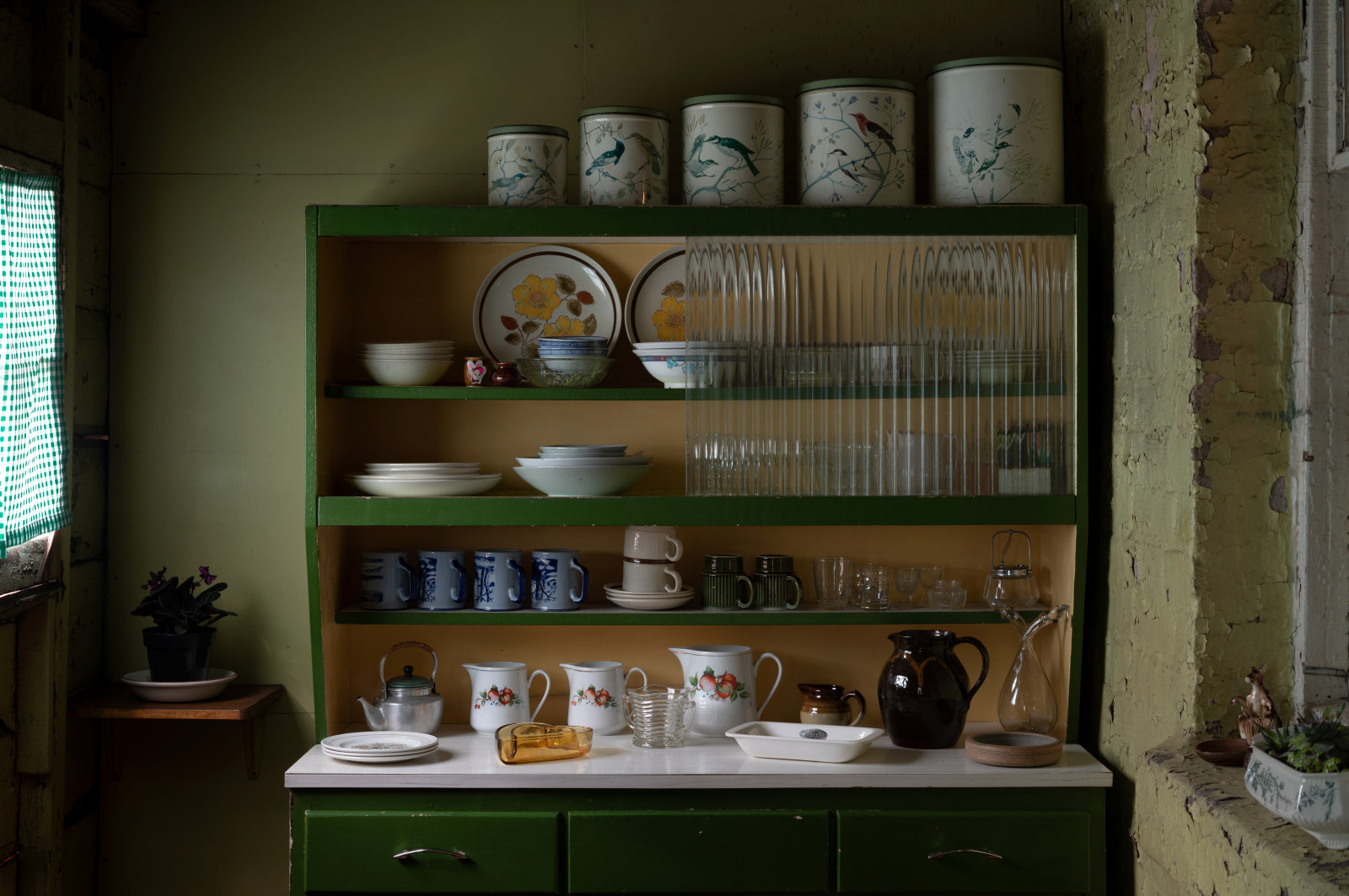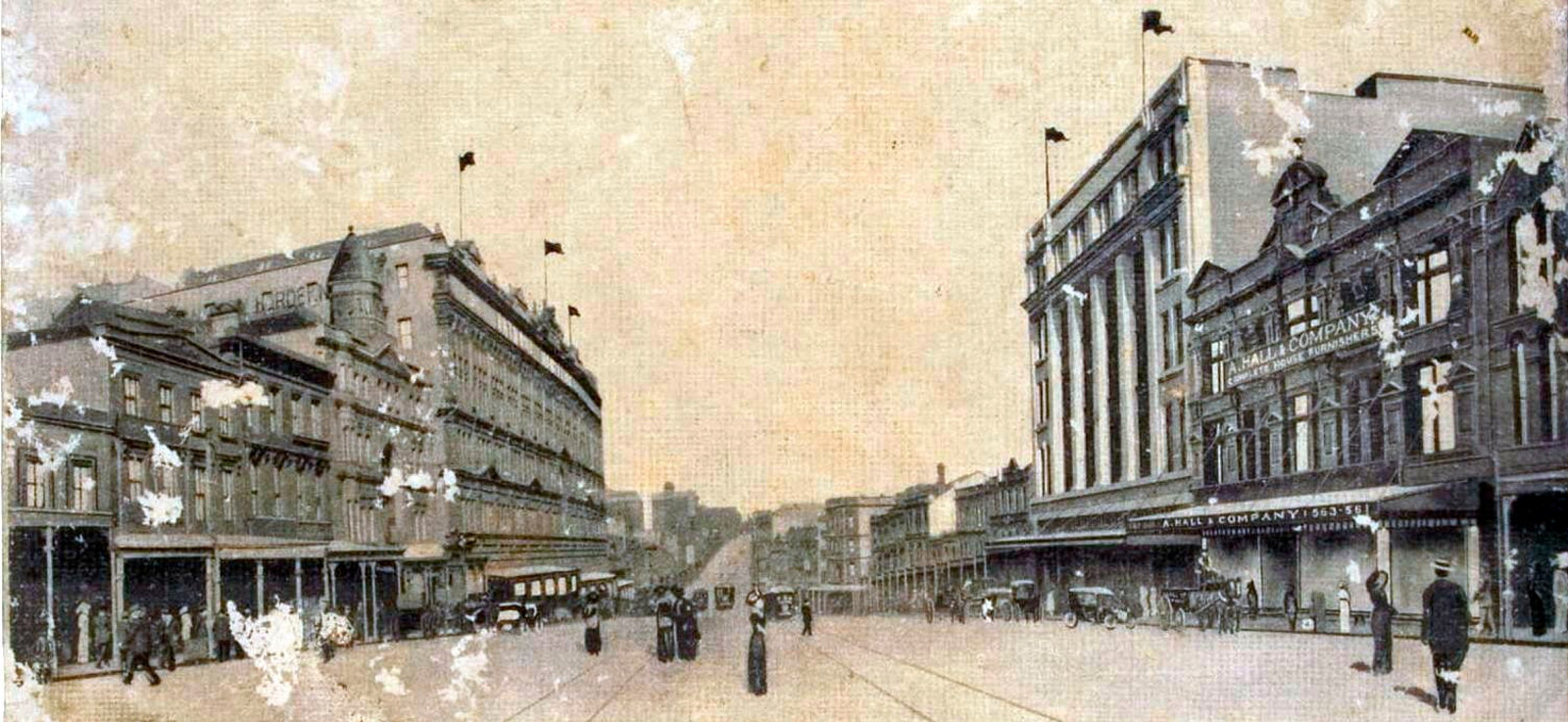Duckenfield Park House Tiles
This small collection of tiles came from Duckenfield Park House, a now demolished mansion built around 1855 near Morpeth in the Hunter River district of New South Wales.
The original house was built by grazier and pioneer pastoralist John Eales (1799-1871) and greatly extended in the 1870s by Eales’ son, John Eales junior (1831-1894), a member of the NSW Legislative Council. The property was sold in 1916 to mining company Broken Hill Proprietary (BHP), who purchased the house primarily for building materials, demolishing the structure in 1917.
The tiles were acquired for the Caroline Simpson Library & Research Collection from the estate of Miss Margaret Owen Perkins, a great-great granddaughter of John Eales senior. They are encaustic tiles, a reference to the medieval method of manufacturing tiles, in which wet clay was pressed into wooden moulds that had been carved in relief to create an intaglio (impression). Once the tiles were dry, the intaglio was filled with coloured slip (a mixture of clay and water) and the two sections fused during firing. Tiles of red clay were commonly inlaid with contrasting buff or blue medieval designs, and generally left unglazed for use as flooring. They could be laid in combination with different shaped tesserae (mosaic pieces) to create repeating patterns. Encaustics were initially used for the floors of 13th-century European churches and cathedrals and gained renewed popularity in England and elsewhere during the Gothic Revival of the early 19th century. At first they were reproduced in the restoration of ecclesiastic buildings, but their use soon extended to civic and domestic architecture. Due to their durability, ease of cleaning and beauty, encaustics featured in the decorative tiling schemes of many public buildings and the entrances, halls, garden paths and courtyards of large houses.
Two of the tiles in this collection were used in the large courtyard at Duckenfield Park House and the third came from a fireplace hearth within the house.
Duckenfield Park House
The original Duckenfield Park House was a large square stone structure, built around 1855 by pastoralist John Eales [1799-1871] on a 2100 acre (850 ha) land grant in the Hunter River district, near Morpeth. John Eales died at Duckenfeld in 1871 and the house and estate was inherited by his eldest son, also named John. The house was of ‘no particular architectural beauty’, according to a description published in the Maitland Mercury on 26 March 1872, and John Eales junior (1831-1894) commissioned major extensions and improvements, creating a 45 room sandstone mansion. The improvements included a billiard room, gymnasium and a ball room measuring 70ft x 50ft with a sprung floor and a musician’s gallery. The Maitland Mercury reported in great detail on the fittings and finishes of the house: gilded ornamental ironwork on the verandah and balconies; the walls of the large hall painted in imitation of Sienna marble and varnished; more than 4000 feet of polished cedar woodwork throughout the house, excluding furniture. The floor of a new verandah, extending around three sides of the house, was ‘laid down with encaustic tiles made by Mr Tornaghi of Sydney, forming an elegant mosaic pattern.’ Other improvements were planned for the future, including a conservatory and a Turkish Bath. It proved an expensive property to maintain. When John Eales junior died in 1894 his property was bequeathed to his five sons. The estate was subdivided and Duckenfield Park House was eventually sold in 1916 to mining company Broken Hill Proprietary (BHP) who demolished it for building materials in 1917.
Minton tile
This tile, used in the courtyard at Duckenfield Park House, is impressed on the back with the manufacturer’s mark, Minton & Co., Patent 6, Stoke upon Trent, and the original plaster mould for the tile is held at the Gladstone Pottery Museum in Stoke-on-Trent in the English midlands. The firm of Minton & Co. was the leading English encaustic tile manufacturer in the mid-19th century.
The company’s first pattern-book of tiles, issued around 1840, included designs based on the recently rediscovered medieval tiles floor of the Westminster Abbey Chapter House.
Consignments of Minton tiles were arriving in Australia by the late 1840s, one Sydney merchant advertising in June 1849 that he had just received a shipment of Minton’s ornamental pavement encaustic tiles. He wished to draw the attention of architects and builders to ‘the cleanliness, durability, warm and ornamental character’ of these tiles, observing that they were ‘now generally adopted in Great Britain for churches, colleges, entrance halls, porticos, verandahs, hearths’. (Sydney Morning Herald 25 June 1849)
This particular tile was designed for Minton by English architect Augustus Welby Northmore Pugin (1812-1852). Pugin was a leading exponent of the Gothic Revival style in architecture and furniture design, using Minton’s encaustic tiles in the many Gothic Revival churches he designed between 1835 and 1852.
Fireplace hearth tile
This tile, also impressed on the back with the manufacturer’s mark, Minton & Co., Patent, Stoke upon Trent, was used in a fireplace hearth inside Duckenfield Park House. It has been inlaid with individual slips of buff, ivory, blue and red to create a simple floral motif of a kind usually placed in groups to create larger designs or in columns to form repetitive patterns on floors, wall panels or around fireplaces.
It is a thicker tile than the other Duckenfield examples because it has been laminated, a process whereby course clay was sandwiched by two finer clay layers to produce a tile with added strength and heat resistance for use in fireplaces. Later industrial research led to a better understanding of firing temperatures and their effect on terracotta and manufactures were able to develop methods of producing thinner tiles with improved durability and heat resistance.
Godwin tile
Encaustic tiles of the Gothic Revival period were typically copies of old designs usually found in churches. Tile bodies were commonly produced in reds and browns and inlaid with ivory coloured patterns to replicate their forerunners. This tile has been decorated with a fleuron motif (a stylised form of flower or leaf), which was used to ornament medieval manuscripts. As ‘pavement’ or for flooring, tiles of this style were used in groups of four to form a larger design. An example can be seen in one the photographs of the courtyard at Duckenfield Park House.
The underside of this tile is impressed with the manufacturer’s stamp: ‘Godwin Lugwardine Hereford’, the mark of Godwin & Co. who began making encaustic tiles in Herefordshire in 1852. Many of the tiles produced by the firm were based on medieval sources.
Courtyard, Duckenfield Park House, 1970s
The courtyard at Duckenfield Park House took the form of a large quadrangle at the rear of the house formed by wings extending from either side of the building. In early 1872 it was stone flagged and ‘enclosed at the back with a dwarf wall and iron railings, with a central iron gate, supported by square stone pillars.’ (Maitland Mercury 26 March 1972)
The dwarf wall and iron railings were continued on to enclose pleasure grounds on either side of the house with a rustic stone building on each corner, each surmounted by a wooden turret, intended as a pigeon house.
The courtyard was later paved with encaustic tiles and fitted with statuary. It survived by several decades the demolition of the house and this photograph shows the tiles, and empty statue plinths, not long before the tiles were eventually lifted in the late 1970s. The Godwin tiles are clearly visible.
Tiling detail, courtyard fountain
This tile arrangement formed one corner of the square that surrounded the central fountain of the courtyard at Duckenfield Park House. A central medallion depicts the interplay of a mermaid and a river diety. The mermaid holds a comb, an ancient nautical symbol of power over nature, in one hand and a mirror in the other, representing the moon. The river deity is Kalamos, shown holding a reed, or bul-rush, a symbol of love in ancient Greek mythology. They are surrounded by encaustic tiles depicting shells, fish and scrolling foliage.
Examples of encaustic tiles
This catalogue of encaustic tiles was produced by a short-lived company formed by George Barr of Worcester in partnership with Fleming St John. The 77 designs included in the catalogue were derived from tiles uncovered by the antiquary John Gough Nichols (1806-1873) in medieval churches in the English counties of Worcestershire and Hampshire. Nichols’ work was published in four parts between c1842 and 1845 and was an influential Gothic Revival source for tile manufacturers both in England and France.
Courtyard fountain, 1970s
In early 1872 the garden embellishments at Duckenfield Park House were a work in progress. The grounds were being laid out by Mr Frederick Creswick, a landscape gardener from Sydney, with terraces and shrubberies and plans for a fountain. (Maitland Mercury 26 March 1972) The fountain shown in this photograph of the courtyard was manufactured by the Coalbrookdale Company, Shropshire, a leading British manufacturer of garden ornament in the 19th century. At their ironworks in Ironbridge Gorge the company produced garden chairs, seats and benches, flower stands, conservatory fittings, vases and urns, statues, garden rollers and fountains. This particular fountain appears in Section III of the company’s 1875 sectional catalogue (held by the Caroline Simpson Library & Research Collection) where it is titled ‘Boys’ and shows that in its original form the boys held a second, smaller basin with a bronze jet. The design was still available and illustrated in the company’s Spring Catalogue issued in April 1888.
Published on
More stories

(Re)making a home
An evocative collection of household items belonging to the last tenants of Susannah Place

Sydney's home furnishing stores
A Hall & Co
A Hall & Co was a retailer of home furnishings and manufacturer of furniture.

A house in the making
After 162 years of being continuously occupied, 62 Gloucester Street was opened to the public for the first time in 2006

A stitch in time
Tatting, knotting, knitting, pin-tucking, crocheting, pinking, stitching, stuffing, embroidering … needles fly at Elizabeth Bay House
